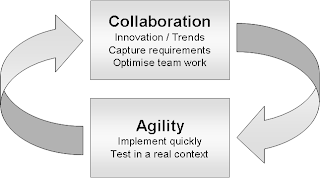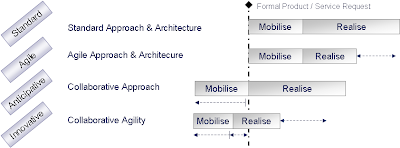I don't think Enterprise 2.0 can be defined by a set of technologies. Let me explain my thoughts on that topic through a very simplistic view of the enterprise world:
- In an Enterprise 1.0 world, composed by the vast majority of businesses today, companies believe they have an understanding of what the market wants, they design products and services, realise a client segmentation and then push their product to these segments with the help of marketing campaigns expecting positive answers. In this Enterprise 1.0 world the focus is based on products and services. In this view of the world companies do not express a real need for more agility because they are convinced that they have THE product, THE service, THE silver bullet that the market wants. This situation is even worse when the company leads already its market segment. An Enterprise 1.0 company doesn't like to fail and pretends that its products and services are perfect (At least on a Marketing point of view). In this 1.0 world companies compete through products and services.
- In an Enterprise 2.0 world, companies understand that the effort should be put on innovation, agily and adaptation. These companies are not afraid to fail because they understand that it's part of the innovation process and that it's a key for success (as per any R&D process). In this 2.0 world, the focus is on the creation of communities (internal or external) that interact to innovate. The innovations (after being qualified) are realised at low cost following agile processes and tested within the community. In this world companies compete through their communities (talents and customers base), their tools and their processes. They understand that products lifecycle is shorter and that products lifetime on the market is getting minimised.
Do I believe that companies will completly go Enterprise 2.0? The answer is no. Companies will mainly remain 1.0 and will address strategically the maket with 2.0 approaches for client facing activities.
Both Enterprise 1.0 and Enterprise 2.0 approaches can coexist. A good example for that is what the French Bank called Caisse d'Epargne has done in France. This Bank has got it's 1.0 corporate website (http://www.caisse-epargne.fr/) and has opened a second website to address the 2.0 approach (http://www.ecureuil.fr/). On its 2.0 Website, Caisse d'Epargne is addressing communication with a community and innovation from the crowd. Last year for instance this bank as provided the community with some drawing tools and has asked customers to design the look and feel of their new credit card. Designs were posted on the side and voted/ranked by the community. The best design (as voted by the community) was applied to new credit cards that were sold to this same community. That's exactly what we are talking about... the community participates in creating the new product that they want, the company has the right talents, tools and processes to implement that innovation and the product is sold back to the community. Nice and easy!Collaborative Agility and Enterprise 2.0 are by nature associated to eachother. The bank example above highlights particularly well this relation.

 We can split a normal project lifecycle in two basic phases, the mobilise Phase and the realise Phase (the operational phase has been removed out of the equation for the simplicity of this exercise):
We can split a normal project lifecycle in two basic phases, the mobilise Phase and the realise Phase (the operational phase has been removed out of the equation for the simplicity of this exercise): An attempt to manage Agility without Collaboration would only allow the company to be reactive, not innovative.
An attempt to manage Agility without Collaboration would only allow the company to be reactive, not innovative.